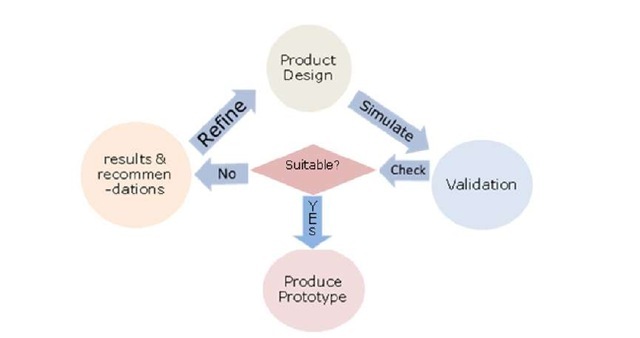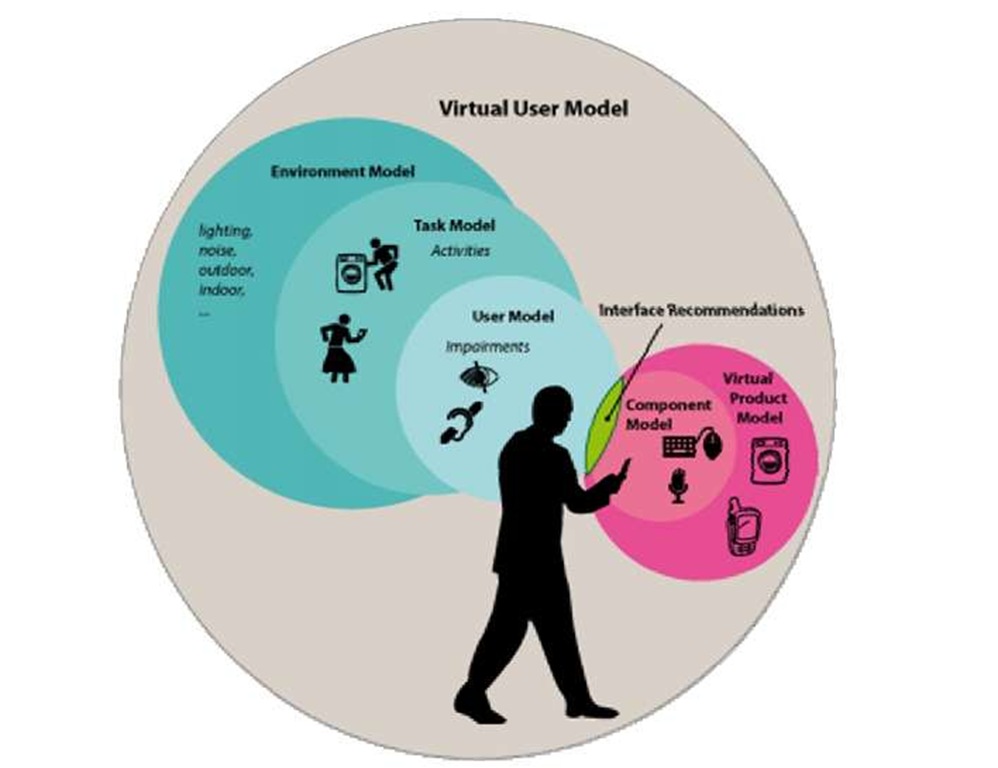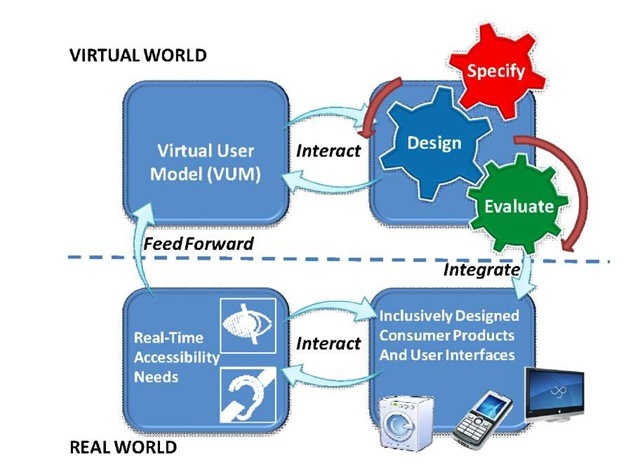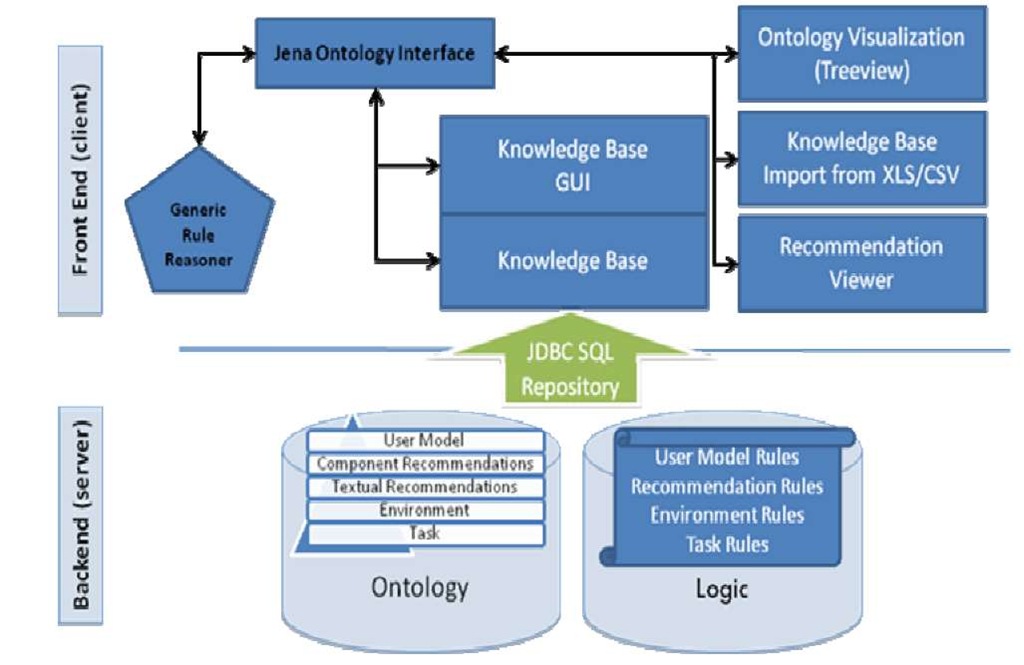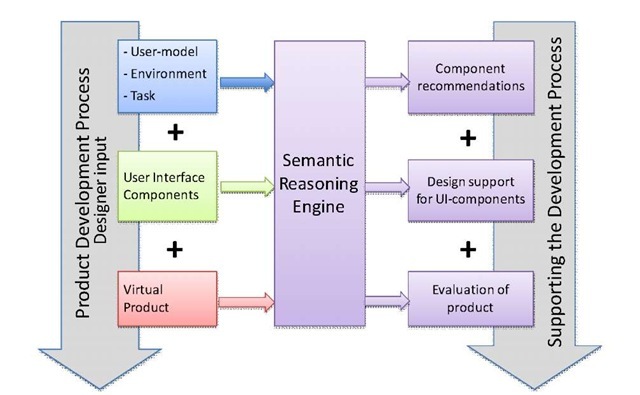By:
Pierre T. Kirisci : Universität Bremen, Bremen, Germany
Martin Hilbig :BIBA – Bremer Institut für Produktion und Logistik GmbH, E-Mail: info@biba.uni-bremen.de
Internet: www.biba.uni-bremen.de
Patrick Klein
Markus Modzelewski :Universität Bremen, Bremen, Germany
Michael Lawo :Universität Bremen, Bremen, Germany
Yehya Mohamad :Fraunhofer Institute for Applied Information Technology (FIT)
Thomas Fiddian :The Royal National Institute for Deaf People LBG (RNID)
Chris Bowden :The Royal National Institute for Deaf People LBG (RNID)
Antoinette Fennell :National Council for the Blind (NCBI)
Joshue O Connor :National Council for the Blind (NCBI)
Abstract
The aim of inclusive design is to successfully integrate human factors in the product development process with the intention of making products accessible for the largest possible group of users. In order to meet this challenge, the involvement of human users has so far been an efficient approach. Yet, such ergonomics evaluation experiments that employ a versatility of user groups can be very time and cost-intensive. Therefore, virtual user models (VUM) have been proposed for supporting certain phases of the product development process. In this paper a model-based design approach is proposed, which supports inclusive design of physical user interfaces of consumer products at the early stages of product development. Accordingly the objective is to explore how virtual user models can be used to conceptualize user interfaces of consumer products in such a way that even the needs of users with physical impairments are fully considered.
Keywords: Inclusive Product Design, Virtual User Models, Product Development, Model-Based Design Approaches.
Introduction
Inclusive design is a process that results in inclusive products or environments which can be used by everyone regardless of age, gender or disability [1]. The main barriers for adopting inclusive product design include technical complexity, lack time cost-effectiveness, lack of knowledge and techniques, and lack of guidelines [2]. Although manufacturers of consumer products are meanwhile less reluctant to invest efforts in user experiments, consumer products nevertheless conditionally fulfil the accessibility requirements of users [3]. The reason is that product tests with users are usually done at a rather late stage of the product development process. Thus, the more progressed a product design has evolved – the more time-consuming and costly is an adaptation of the product design. Evaluating alternatives from an accessibility standpoint, when it is still relative inexpensive to change the design, can improve the accessibility features of the product [4]. As a consequence, there is a substantial demand for methods and tools which are capable of credibly replacing experiments with human users in the early product development phases.
One promising practice for realizing inclusive product design is to employ virtual user models (VUM). Virtual user models can be seen as an abstract representation of the simulated behaviour a human user. According to contemporary definitions, virtual user models are three-dimensional, model-like images of reality and usually contain the following functions: (1) Human body modelling and analysis (2) Animation of virtual users (3) Interaction of virtual users with virtual objects [5].
Nowadays virtual user models are utilized for ergonomic analysis in vehicle and workplace design within the automotive or aerospace industry. They are used to validate the design in a simulation environment, check in a loop if the design is suitable, refine it considering recommendations and best practices and finally, when found suitable produce a prototype to be checked by end users as shown in Fig. 1.
Fig. 1. General usage approach of virtual user models in inclusive product design
More rarely are virtual user models applied in the evaluation of user interface designs of consumer products, and even less for usability and accessibility of consumer product’s interfaces – although having similar objectives for inclusive design processes. For the specification phase static models of the user are applied, while during the design phase virtual user models of humans can have the notion of three-dimensional human models, in most cases incorporated as an enhancement of CAD applications (e.g. Human Builder for CATIA [6]). Despite the different approaches which involve virtual user models, only the approach of the so called digital human models, which are a sub-category of virtual user models, based on anthropometrical data are suitable for serious simulation and can meet the ambitious goals of the accessibility evaluation of user interfaces of consumer products at the early stage of the development process. However, there is neither a common framework, nor a common understanding of how elements involved in the creation, development, and interaction of virtual user features are done. As such the usage of virtual user models for a continuous support of specification, design and evaluation phases can therefore be considered as unique. Thus, contemporary approaches where virtual user models are utilized are only partially suitable for inclusive design.
Related Work in Virtual User Models
The first attempts to develop virtual user models began in the 1960′s when the digitization of two-dimensional anthropometric models became available. In the early years and decades many research groups from industry as well from universities followed their own proprietary approaches, because the costs of the realization of such models were comparatively low. The concepts ranged from a representation of a human as simple composition polygonal main body of the modelling from many horizontal layers up to the representation of a variety of stapled balls. Further developments were mostly driven by specific requirements from the industry. The majority of these models were mainly developed for the areas of aerospace and design of airplanes, where training and experiments on real tasks were mostly expensive or impossible; therefore they had to be simulated and one element of such simulations were virtual user models. In the further course – mainly in the 1980s – the features of today’s Human models became more mature. Some special solutions were used and improved others were just redesigned, but the actual human models have been more versatile and comprehensive in their functions. This led to the fact that the number of models has decreased, because the effort to create new models has become much more complicated [7].
User modelling on the other hand is an established area of HCI (Human-Computer Interaction). However, most of the conventional user models do not consider possibilities of unexpected error modes or influences of body shapes and movements of users. The scope of usability assessments also tends to ignore spatial relationships between users and objects of their environment. Furthermore, user models have been implemented by proprietary infrastructures to manage and query their respective models. These models are in the first place complex data structures revealing many similarities to VUMs in the way they are structured, managed and how they are consumed by services.
Virtual users have also been suggested for testing, such as trying the capacity of search engines or other interactive web applications in handling different cases, but also mass usage and scalability. This approach was practiced already over 20 years ago [8], and still is being used [9]. Yet these approaches do not require individual virtual entities, but can work on statistical models, for instance. Toru Nakata, et al reported of a virtual user prototype that simulates human machine interaction including errors in body actions and mistakes in cognitive decision, they used it for simulation of a car driver, the virtual user model generates human-like body movements and error escalations in cognitive process [5]. In this respect, many important software models were created such as Anthropos BoeMan (1969), CyberMan (1988), Franky (1988), CombiMan (1988), ER-GOMan (1988), TEMPUS (1988), CrewChief (1990), ErgoMAX (1998), Ergo (1998) or Safework (Safework 2000). Many of these models were developed as standalone models or were partially merged or integrated into other models.
Towards a Model-Based Approach for Inclusive Design of User Interfaces
Conceptualization of the VUM
Since a virtual user model as an abstract representation of an envisaged user group which includes a description of the underlying context, it is legitimate to consider the VUM as a context model. Context represents on a universal scale, the relevant aspects of the situations of the user groups [10]. Hence, a context model describes the characteristics, features, and behaviour of a specific user group. Complementarily it also includes the aspects related to the tasks, interactions, user interface, and the environment, where she or he interacts with consumer products as highlighted in Fig. 2.
Fig. 2. Aspects of a Virtual User Model (VUM)
Accordingly, the VUM as proposed in this paper possesses different facets for supporting the development process. Fig. 3 provides an overview of the underlying concept emphasizing the interplay between the virtual and real world. The virtual user model is based upon real-time accessibility needs of the envisaged end user groups. In the virtual world the VUM interacts with the specification, design and evaluation phase of a product. It is foreseen that the support by the VUM works in the following way: In the initial specification phase, a support appears in form of text-based recommendations with respect to potential user interface elements. In the design phase the VUM will guide the designer with templates and design patterns for interaction components of consumer products. For the evaluation phase, a 3D virtual character in a virtual environment will be established in order to evaluate a conducted product design against predefined usage scenarios. After several iterative development cycles, the results are then used for realization of a physical prototype and final product in the real world.
In summary, the VUM approach should go beyond existing approaches by:
• Accompanying the design process from the scratch until the final CAD design cycle, by providing different standalone recommendation systems for the idea finding stage, the sketch phase and components for integration with CAD systems,
• Incorporating different accessibility features in the user profiles,
Fig. 3. Overview of the Approach
• Adding new reporting mechanisms e.g. web based reports and visual responses in the virtual user itself.
As an example, a designer is planning to design a new product such as a mobile phone would like to incorporate accessibility features into the future mobile phone. The designer invokes the recommendation system, selects from the device list “mobile phone” and configures from the “target user group” the target user group. Based on the entered information the system lookups into its repositories and displays for him a list of existing use cases and additionally links to existing guidelines. In the further course the designer makes a scratch layout of the future mobile phone, saves it and imports it to the recommendation system. The system then displays more accurate recommendations dedicated to the scratch layout and the selected target user group.
The other component required is a 3D virtual user system, which allows either the development of CAD designs or the import of CAD designs into it and provides analysis tools. It will allow the assignment of tasks to the virtual user. An execution procedure reports the results visually to the designer.
Implementation of the VUM
It is compulsory that the VUM should possess the capability of determining guidelines and recommendations of appropriate interaction components for a consumer product. Therefore, the VUM should incorporate appropriate partial models which incorporate the context to determine proper recommendations. A suitable taxonomy for the VUM may consist of at least of the following sub-models:
• User Model, where all information about a Virtual User such as physical impairments or diseases are stored. User Models could be divided into several subgroups (Profiles), where for every criterion the profiles are divided into different levels of impairments. Additionally there are mixed profiles describing the group of elderly people suffering upon a mixture of hearing, sight and dexterity impairments. Component Model, where pre-defined hardware components are stored (e.g. coloured buttons, visual display, etc.), which will be presented as recommendations.
• Model for Textual Recommendations, where guidelines are stored. These may consist of the predicates “Name”, “Text”, “Summary” and an Attachment, where e.g. the user can get guidelines, which he or she can use for the sketch phase.
• Environment Model, where all environment-related data is stored. That includes the physical conditions of the environment of the real world, objects and characteristics of the environment etc.
• Task Model, describes how to perform activities to reach a pre-defined goal. This model may be based e.g. on Hierarchical Task Analysis (HTA)1 providing an interface, where the designer can define actions of the user for the evaluation in the virtual environment.
In relation to functional requirements, such as gaining of component recommendations as an output, the virtual user model needs to be able to parse the sub-models using logical constraints. This is necessary in order to build an inference model with all relevant data.
For the implementation, an architecture is proposed, which includes the VUM as a knowledge base. The architecture (Fig. 4) consists of a frontend and backend part: In the frontend the client application connects itself with a server (backend) through a Java Interface for SQL (JDBC), where all information regarding the user models, recommendations, environments and tasks is stored to acquire the latest version. Through the application of a Reasoner or semantic reasoning engine, a new ontology model is sequentially created which consists of all available data. In the backend all data is stored in a SQL Database including a timestamp for versioning support. Afterwards the Knowledge Base builds the complete Virtual User Model as seen in the next section. By using a Generic Rule Reasoner and the Jena Ontology Interface the application is able to perform requests to the Ontology to present the needed instances. Additionally the sketch phase system includes also Visualization, Import from XLS / CSV files and a Recommendation Viewer to present the results to the designer.
While Fig. 4 highlights the underlying architecture in relation to the sketch phase, Fig. 5 focuses upon the support of the VUM-based system which is provided during the whole product development process (sketch phase, design phase, evaluation phase).
As in the sketch phase, the only input the system receives by the designer is the selection of a user, environment and task model, the second phase deals with a detailed design of a user interface of a product. In the third and final phase (evaluation phase) the system is in the status of possessing the most advanced quality and quantity of information to generate recommendations. In each phase the designer is currently involved, his/her input is incorporated.
Fig. 4. Architecture for sketch phase
Fig. 5. Overview of the support provided during the whole product development process
At the same time the underlying knowledge base increases, which leads to the situation that the system is signed by additional information in order to generate appropriate recommendations.
The “Semantic Reasoning Engine” in centre of Fig. 5 is based upon the already described modules (Knowledge base, Reasoner, etc). In analogy to the sketch phase, in all other phases, logical consequences are being inferred from a set of asserted rules as proposed in 4.2. In a practical sense, the Semantic Reasoning Engine can be considered as an enabler for determining results for supporting the design process.
Inference of the VUM
The sequential creation of inference models of the Virtual User Model is divided into 5 steps, which apply specified rule sets by every one step as illustrated in Fig. 6. Iterative Creation of Recommendations during the Sketch Phase:
1. Applying of user model Rules
The General Rule Reasoner uses the user model rules to define all instances of the user model class as members of specified WHO ICF profiles (e.g. “HProfile2″ for severe hearing impaired people).
2. Generation of component Recommendations
Until this step, all component recommendations are only members of the recommendation class. The Reasoner applies rules, which defines all instances of these recommendations as members of the WHO ICF profile groups. So after this step every user is a member of a profile class, which has analogue recommendation profile classes (e.g. “HProfile2_Reco” consists of all component recommendations for the profile of severe hearing impaired people).
3. Generation of textual Recommendations
This step is the same as the second step, with the difference to use the textual recommendation rules and instances.
4. Creation of environment Recommendations
This step creates classes based on the names of every environment, followed by a “_Reco” and adds all textual and component recommendations, which were reasoned by the environment rules, as members of these new recommendation classes (e.g. “Kitchen_Reco” is the recommendation class for the environment with the name: “Kitchen”). These rules can also use the previous defined recommendation classes.
Fig. 6. Iterative Creation of Recommendations during the Sketch Phase
Creation of task recommendations
The last step creates all task related recommendations based on task rules and all reviously defined recommendations.
Conclusions
In this paper a model-based design approach was presented based upon the creation and implementation of a virtual user model. It was shown that the design approach is potentially capable of supporting the early product development stage (before realizing of physical prototypes) by providing component and design recommendations. So far the feasibility of the approach during the sketch phase has been demonstrated by implementing the virtual user model according to the architecture specified in Fig. 4. Through the introduced virtual user approach it was shown that insufficient knowledge of product designers regarding the needs of people with mild and moderate age-related impairments can be completed. The benefit for mainstream manufacturers of consumer products is obvious as they would be able to develop their products in an inclusive manner, making them accessible for users with mild to moderate impairments, thus at the same time remaining attractive for non-impaired users as well. On behalf of this thesis, it is particularly interesting to investigate the feasibility of the approach in the second (design) and third (evaluation) phase.
Future Work
In the next stage it is foreseen to determine how the VUM can support the designer in the design and evaluation phase. A main challenge will be to seamlessly integrate the VUM into existing product development processes of companies, e.g. integrated into mainstream CAD applications. In this respect, a design support through the VUM may involve presenting qualitative and quantitative recommendations based on the specified values in the CAD software. These recommendations may consist of a unified set of previous shown guidelines, partial components and additional information particular regarding the design of a product.
In order to obtain the practical value of the approach, it is therefore foreseen to test and validate the VUM, based upon two real design cases: (1) mobile phone and (2) washing machine in close cooperation with two well-known consumer goods manufacturers. The aim shall be to confirm the benefits of the proposed design approach on a practical scale, but also to identify the limits of a virtual user model-based design support to the research community and design industry.
